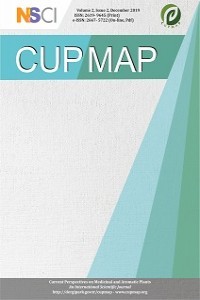Volatile and Phenolic Compositions of the Leaves of Two Vinca L. Species from Turkey
Volatile and Phenolic Compositions of the Leaves of Two Vinca L. Species from Turkey
Periwinkle endemic, Turkey,
___
- Benavente-Garcıa, O., Castillo, J., Lorente, J., Ortuno, A., & Del Rio, J. (2000). Antioxidant activity of phenolics extracted from Olea europaea L. leaves. Food Chemistry, 68(4), 457-462.
- Brandao, E. M., Brandão, P. H., Souza, I. A., Paiva, G. S., Carvalho, M. d. C., & Lacerda, C. M. (2013). Antineoplastic effect of aqueous extract of Plectranthus amboinicus in Ehrlich ascites carcinoma. Journal of Cancer, 4(7), 573.
- Brogan, C. (2010). Alkaloids cancer treatments. Retrieved from http://www.Vinca alkaloids\AlkaloidsCancer Treatment Livestrong_com.mh
- Cai, Y., Luo, Q., Sun, M., & Corke, H. (2004). Antioxidant activity and phenolic compounds of 112 traditional Chinese medicinal plants associated with anticancer. Life Sci, 74(17), 2157-2184. doi:10.1016/j.lfs.2003.09.047
- Cheynier, V. (2012). Phenolic compounds: from plants to foods. Phytochemistry Reviews, 11(2-3), 153-177.
- Guo, X., He, D., Yang, L., Li, Y., Chen, Q., Chen, J., Zhang, E., Lin, X., He, J., Yang, Y., Han, X., Zheng, G., Wu, W., Zhao, Y., Huang, H., & Cai, Z. (2015). Quercetin Displays Anti-Myeloma Activity and Synergistic Effect with Dexamethasone in Vitro and In Vivo Xenograft Models. Blood, 126(23), 5339.
- Güner, A. (2012). Türkiye bitkileri listesi:(damarlı bitkiler): ANG Vakfı.
- Han, X., Shen, T., & Lou, H. (2007). Dietary polyphenols and their biological significance. International Journal of Molecular Sciences, 8(9), 950-988.
- He, D., Guo, X., Zhang, E., Zi, F., Chen, J., Chen, Q., . . . Wu, W. (2016). Quercetin induces cell apoptosis of myeloma and displays a synergistic effect with dexamethasone in vitro and in vivo xenograft models. Oncotarget, 7(29), 45489.
- Koyuncu, M. (2012). A new species of Vinca (Apocynaceae) from eastern Anatolia, Turkey. Turkish journal of botany, 36(3), 247-251.
- Koyuncu, M., Ekşi, G., & Özkan, A. M. G. (2015). Vinca ispartensis (Apocynaceae), a new species from Turkey. Annales Botanici Fennici, (52, 5-6). BioOne.
- Ma, Y., Jin, Z., Huang, J., Zhou, S., Ye, H., Jiang, S., & Yu, K. (2014). Quercetin suppresses the proliferation of multiple myeloma cells by down-regulating IQ motif-containing GTPase activating protein 1 expression and extracellular signal-regulated kinase activation. Leukemia & lymphoma, 55(11), 2597-2604.
- Mah, S. H., Teh, S. S., & Ee, G. C. L. (2017). Anti-inflammatory, anti-cholinergic and cytotoxic effects of Sida rhombifolia. Pharmaceutical biology, 55(1), 920-928.
- Middleton, E., Kandaswami, C., & Theoharides, T. C. (2000). The effects of plant flavonoids on mammalian cells: implications for inflammation, heart disease, and cancer. Pharmacological reviews, 52(4), 673-751.
- Nishibe, S., Takako, T., Takahiko, F., Yasukawa, K., Takido, M., Yasujiro, M. Akira, H. ( 1996). Bioactive Phenolic Compounds from Catharanthus roseus and Vinca minor. . Nat. med., 50:, 378-383.
- Proestos, C., Chorianopoulos, N., Nychas, G.-J., & Komaitis, M. (2005). RP-HPLC analysis of the phenolic compounds of plant extracts. Investigation of their antioxidant capacity and antimicrobial activity. Journal of agricultural and food chemistry, 53(4), 1190-1195.
- Puupponen‐Pimiä, R., Nohynek, L., Meier, C., Kähkönen, M., Heinonen, M., Hopia, A., & Oksman‐Caldentey, K. M. (2001). Antimicrobial properties of phenolic compounds from berries. Journal of applied microbiology, 90(4), 494-507.
- Qıan, Y., Zhang, L., Chen, Q.-s., Zhang, Y., Xıao, D., Wen, X.-q., & Zhao, W.-l. (2012). Catechins induce apoptosis of multiple myeloma RPMI 8226 cells and its mechanism. Tumor, 32(1), 1-6.
- Ramalakshmi, S., & Muthuchelian, K. (2011). Analysis of bioactive constituents from the leaves of Mallotus tetracoccus (roxb.) Kurz, by gas chromatography-mass spectrometry. International Journal of Pharmaceutical Sciences And Research, 2(6), 1449.
- Sahelian, R. (2011). Alkaloid substances in plants, information on vinca, ergot and ephedra alkaloid compounds. Retrieved from http://www.raysahelian.com/alkaloid.html
- Saral, Ö., Şahin, H., & Karaköse, M. (2015). Vinca major subsp. hirsuta’nın antioksidan aktivitesinin ve RP-HPLC-UV ile fenolik bileşenlerinin belirlenmesi. Artvin Çoruh Üniversitesi Orman Fakültesi Dergisi, 16(2). doi:10.17474/acuofd.59141
- Shan, B., Cai, Y. Z., Sun, M., & Corke, H. (2005). Antioxidant capacity of 26 spice extracts and characterization of their phenolic constituents. J Agric Food Chem, 53(20), 7749-7759. doi:10.1021/jf051513y
- Stearn, W. (1978). Vinca L. . In D. PH (Ed.), Flora of Turkey and the East Aegean Islands (Vol. 6, pp. 161-163). Edinburgh: Edinburgh University Press.
- Stearn, W. T. (1973). Synopsis of the genus Vinca including its taxonomic and nomenclatural history. In W. Taylor & N. Farnsworth (Eds.), The Vinca alkaloids; botany, chemistry, pharmacology (pp. 19-94).
- Swamy, M. K., Arumugam, G., Kaur, R., Ghasemzadeh, A., Yusoff, M. M., & Sinniah, U. R. (2017). GC-MS Based Metabolite Profiling, Antioxidant and Antimicrobial Properties of Different Solvent Extracts of Malaysian Plectranthus amboinicus Leaves. Evidence-Based Complementary and Alternative Medicine, 2017.
- Verma, S., Singh, A., & Mishra, A. (2013). Gallic acid: molecular rival of cancer. Environ Toxicol Pharmacol, 35(3), 473-485. doi:10.1016/j.etap.2013.02.011
- Yulianto, W., Andarwulan, N., Giriwono, P. E., & Pamungkas, J. (2016). HPLC-based metabolomics to identify cytotoxic compounds from Plectranthus amboinicus (Lour.) Spreng against human breast cancer MCF-7Cells. Journal of Chromatography B, 1039, 28-34.
- ISSN: 2619-9645
- Yayın Aralığı: Yılda 2 Sayı
- Başlangıç: 2018
- Yayıncı: Nazım ŞEKEROĞLU
Microbiological Property Evaluation of Natural Essential Oils Used in Green Cosmetic Industry
Ecem ÖZDEMİR, İsmail ASLAN, Bekir ÇAKICI, Betül TÜRKER, Cem Emre ÇELİK
The Potential of Marine Resources in Cosmetics
Levent ALPARSLAN, Nazım ŞEKEROĞLU, Anake KIJJOA
Studies on Natural Cosmetic R & D – From Laboratory to Prototype Product
İlkay ERDOĞAN ORHAN, Fatma Sezer ŞENOL DENİZ
Gökhan CENGİZ, Evren ALGIN YAPAR
Volatile and Phenolic Compositions of the Leaves of Two Vinca L. Species from Turkey
Ela Nur ŞİMŞEK SEZER, Tuna UYSAL
Tea Tree Oil and Its Use in Aromatherapy
Ufuk ÇALIŞKAN, Müjgan ÖZFENERCİ
Detection and Quantification of Preservatives in Green Cosmetics
Evren ALGIN YAPAR, Nilay CİVİL, Ebru ÜNCÜOĞLU
International Standards of Microbiological Quality in Cosmetic Products
